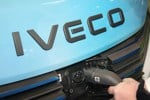Sales have soared and fleets are increasingly supplying drivers with portable units. There is an initial outlay for units but system manufacturers claim the long-term cost savings far outweigh these preliminary costs.
Most portable units hover around the £299 price tag, which is much cheaper than manufacturer-installed units which tend to cost about £1,000.
But still, for a 100-strong fleet the outlay is likely to be £30,000.
However, if there are problems with ‘lost’ drivers or delayed deliveries the cost will be recouped by reduced mileage and improved fuel economy figures.
There is plenty of choice and fleets can usually negotiate a discount.
High street stores such as Halfords and Argos have a good range but for a bulk order you would be better off approaching individual companies as better discounts may be found.
Fleet manager and Fleet News Award winner John Bradley of Hampshire Constabulary is trialling the Trafficmaster SmartNav system for 12 months.
He said: ‘We believe it will help drive down unnecessary mileage and improve response times and driver and public safety.’
The sat-nav boom has come over the past three years and research from market research group Roper Consulting has shown that UK households now own more satellite navigation units than any other country in Europe, except for Sweden.
However, the boom has also raised additional issues such as driver distraction and theft, which should be addressed by fleets.
Most portable units are suckered to the front windscreen and drivers should be advised not to programme them while on the move. There is also the issue of security and units should always be placed out of view while the vehicle is empty.
Nigel Doggett, managing director of Autoglass, said: ‘There is the risk of smash-and-grab thieves who cannot resist the lure of a lightweight, hi-tech and high priced gadget. According to the Autoglass Cracking Car Crime Report 2005, 25,900 satellite navigation systems were taken between October 2004 and October 2005 and the figure is increasing all the time.
The Fleet NewsNet team tested six portable sat-nav units during a two-week period, including a trial run to a destination in the centre of Peterborough.
All units were programmed with the same destination and it was a team effort to see who arrived first, sticking to speed limits and following the instructions even if they seemed to be sending them the wrong way.
Deputy editor Steve Moody claimed first prize with the Navicore followed by reporter Phill Tromans using the Snooper Indago. The rest of the team followed closely behind, demonstrating how closely matched the systems are in a well-mapped East Midlands city.
AA Navigator
PRICE: £299.99
TESTER: Sandie Hurford
I LOVED being able to use the stylus to negotiate my way around the menu and keying in destinations was a piece of cake compared with the often unwieldy and inaccurate joystick toggle/knobs you get on in-car systems. It was also really useful to be able to play around with the hand-held computer out of the car.
Anyone with a series of destinations to input would find it a real bonus to be able to set them at their desk rather than waiting until they were sitting behind the wheel. I didn’t use any of the other functions as this was primarily a sat-nav trial but I’m sure they would have worked just as efficiently.
The in-car siting unit didn’t look that sturdy but proved remarkably resilient in use. I put it on the windscreen but after reading the instructions more thoroughly I believe it should have been placed on the air-vent where it would not have obstructed the driver’s view at all.
My only problem came one day after the test when it ran out of battery power and, on plugging it into the cigar lighter with the provided cable, it switched itself off. I think the battery has to be topped up via the mains or a computer and then the cigar lighter used to stop it running down but it was extraordinarily difficult to ascertain that from the instructions.
Plus
Navicore Personal 2006
PRICE: £199.00 plus software (up to £118)
TESTER: John Maslen/Steve Moody
ALTHOUGH the instruction manual, disks and wires were daunting, this product is a matchbox-sized GPS unit and a simcard for a compatible Bluetooth-enabled mobile phone. Stick the simcard in your phone, launch the Navicore programme, link to the GPS system and you are away.
It took seconds to master. Full six-digit postcode entries make it really accurate and guidance is clear, although on roundabouts, it is a bit slow, so you have to keep an eye out for signs. The screen is as big as your mobile phone allows, but there is a safety mode where a big arrow guides you. I found no trouble getting around, although possibly it would have been harder should I have needed to look at the map. The phone screen is not very big, and peering into it trying to work out a complicated junction would be awkward.
The best part is that when you arrive, you just have one piece of equipment to take with you. Mobile phone and GPS all in one handset. One problem is that if you’ve stored any pictures or too many texts, there is not enough memory. Also, the buttons of the phone are not very user-friendly compared to bespoke sat-nav units. Finding where various settings and functions are is not easy, especially on the move, where it could be considered extremely distracting.
Plus
Negative
Navman iCN520
PRICE: £249.00
TESTER: Adele Burton
IN TERMS of programming this is probably one of the easiest sat-nav units I have ever used. Call me sexist, but I adopted the male philosophy and thought I’d get away with using the system without looking at the manual first. Surprisingly it worked.
The unit, which is similar to a hand-held computer complete with stylus, is so straightforward I was able to programme my destination with ease. It helped being able to enter a full postcode. The stylus not only prevents grubby finger marks on the screen but is much easier to use than the mini-joysticks found on a lot of factory-fit units.
The map can be viewed in four formats, I favoured the 3-D version which views the approaching road from a side angle rather than overhead. It has all the usual options such as quickest or shortest route and easy-to-access menus.
I had the unit attached to the windscreen but found I listened to the instructions rather than looked at the map, this limited distraction from the road and the clear consider instructions were accurate and simple to follow. Portable units are a lot smaller than factory-fit versions making maps more difficult to follow. Also, they cannot be used in vehicles with heated front windscreens as the GPS signal is disrupted.
Plus
Negative
Road Angel Navigator
PRICE: £399.99
TESTER: Mike Roberts
ON our test route, the unit worked perfectly, getting me to the required destination quickly using a direct route through the centre of town. Programming the destination was an easy process using the touch screen.
Access the ‘going to’ screen by pressing the ‘going to’ button and once the route has been stored, simply activate the route guidance by pressing the ‘start driving’ button. I had to input the address manually as it didn’t recognise the postcode but it has for other addresses since.
The audio instructions given to the driver were clear and concise and these can be set to start two miles, one mile or 0.3 mile away from the next move. The map was easy to read and depending on how far away the driver is from their next action point it would alternate between a close-up view and one further away showing the final destination point.
While the unit is pleasing on the eye it’s not so kind on the ear – shrill beeps are produced when the vehicle approaches a speed camera or accident blackspot, but it can be muted.
The system comes with a free subscription for six months of database updates and product support but its makers stress it is ‘critical’ to keep the subscription up to date for it to work properly. This costs £3.99 a month.
Plus
Negative
Snooper Indago
PRICE: £499.00 plus £49 subscription
TESTER: Phill Tromans
THE Indago unit is one of the more compact on the market. As well as comprehensive UK road coverage, it includes a database of speed camera positions. The warning of upcoming devices can be handy, particularly given many drivers’ habit of heavy braking when they spot a yellow box.
The Indago is intuitive to use, and I never had to look at the manual. Turn it on and the bright, clear display is easy to read. Touching the centre of the screen brings up the menu, which has options to enter a destination by full postcode, part postcode or full address. There were a couple of postcodes that weren’t recognised, but it was easy to use the address.
A useful feature is being able to search by points of interest (POI), from airports and tourist attractions to petrol stations. Such searches include the name and phone number of the POI. This became invaluable when searching for a nearby petrol station. The routes worked out by the Indago are generally fine, bar a couple of attempts to send me the wrong way up a one-way street. But deviate from the prescribed route and it’s quick to catch on and re-route.
The only downside is the price – £499, plus subscription of £49 a year for camera database updates after the first six months.
Plus
Negative
TomTom One
PRICE: £279.99
TESTER: Jeremy Bennett/Kate Batchelor
THE GO One is the entry level navigation system in the TomTom ‘all-in-one’ range for cars and motorbikes. It has an RRP of £279.99 while the top-of-the-range GO 700 costs £549.99.
Testing the One was an experience of extremes. It was not made clear in the instructions that I would need to go online before I could use it in order to get an authorisation code to activate the system. And in order to get that code you need to type in a string of digits that come with the unit.
However, once the system was activated the experience was as good as TomTom promises.
Power comes from your cigarette lighter or 8v power supply to a rechargeable battery and the One comes equipped with its cradle and memory card of UK maps.
Installation and choosing my first route (to Castle Donington on the M1) took less than a minute, including setting the current time, choosing the voice and its volume and the units of measurement. Unlike many other systems I’ve used, it is really easy to navigate purely by a postcode. The route guidance was clear and the graphics easy to read while driving. I was so impressed by ‘the One’ that I would question the need to look any further up the GO range.
Plus
Negative













Login to comment
Comments
No comments have been made yet.